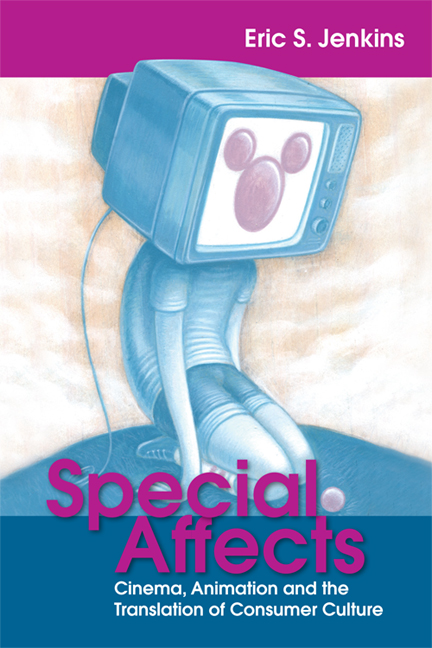Book contents
- Frontmatter
- Contents
- Acknowledgements
- List of Illustrations
- 1 Introduction
- 2 Astonishment and the Fantastic in Live-Action Cinema
- 3 Say Cheese! The Cinematic Lifestyle Consumer
- 4 Animation's Marvel and the Graphic Narrative Mode
- 5 Of Mice and Mimesis: The Wondrous Spark of Disney
- 6 Mutual Affection-Images and Daydreaming Consumers
- 7 The Disney Version of the American Dream
- 8 Walt and Wall-E in Control Society
- Movies Referenced in Special Affects
- Notes
- Index
6 - Mutual Affection-Images and Daydreaming Consumers
Published online by Cambridge University Press: 05 August 2016
- Frontmatter
- Contents
- Acknowledgements
- List of Illustrations
- 1 Introduction
- 2 Astonishment and the Fantastic in Live-Action Cinema
- 3 Say Cheese! The Cinematic Lifestyle Consumer
- 4 Animation's Marvel and the Graphic Narrative Mode
- 5 Of Mice and Mimesis: The Wondrous Spark of Disney
- 6 Mutual Affection-Images and Daydreaming Consumers
- 7 The Disney Version of the American Dream
- 8 Walt and Wall-E in Control Society
- Movies Referenced in Special Affects
- Notes
- Index
Summary
Disney's full-length features of the 1930s and 1940s create an interface for animistic mimesis by actualising animation's potential for transfer and transformation in mutual affection-images. Although Disney's features follow much of the movement-image regime, mutual affection-images mark Disney as one of the first to begin the transition to time-images, enabling a direct experience of time, of affection, of life. As such, Disney's translation will have a unique impact on consumer culture, one that extends into the affect economy and controls society today. This unique impact occurs because the mutual-affection images offer an interface for the innervations of wonder, and the mode of animistic mimesis makes visible a daydreaming consumer bent on the pleasures of self-affection much closer to commodity fetishism than cinema's lifestyle consumers. How, then, does Disney employ the formal features described in the previous chapter to create an interface for animistic mimesis?
It would be easy to show that, despite their cinematic features, Snow White, Pinocchio and Dumbo employ the characteristics of animistic mimesis described in the previous chapter, from the use of colour and shadows to the synchronisation of sound and movement, from the drawing of gestures to the squashing and stretching rhythms. Each story features hybrid characters, including the dwarfs in Snow White, the boy-puppet Pinocchio, the flying elephant Dumbo, talking animals, and numerous mythical and mysterious characters practising magic. In almost every scene, water, fire, smoke, bubbles, rain or lightning transfer(s) colours from surface to surface, forming a musical play of colour. Music, in particular, is an essential element. Lest anyone doubt the constant fusion of sound and movements, they need only learn that, at Disney, the conductor and director planned the entire movie together before any animator ever began to draw. Each movie has multiple musical numbers where the characters move rhythmically to the music. In fact, the bulk of the viewing time consists of musical numbers, and each feature produced a hit song. Characters move to the music and then, at times, the direction reverses and their crashes, bangs or pranks move the music as well. The music and characters experience a mutual affection, in nearly every moment on the screen, so much so that the movies are practically musicals.
- Type
- Chapter
- Information
- Special AffectsCinema, Animation and the Translation of Consumer Culture, pp. 139 - 167Publisher: Edinburgh University PressPrint publication year: 2014



